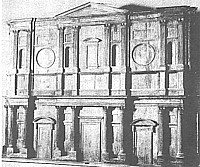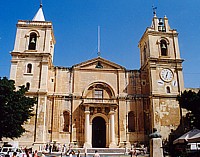<gerolamo
cassar and his architectural influences
- part 2 -
However, Cassar’s plain and rather austere building style also resulted from his training in military architecture and engineering by the Italian engineer Francesco Laparelli. Through his work as Laparelli’s assistant during the building of Valletta from 1566 onwards, Cassar indirectly got into contact with the architecture of Italy. Back in Rome, Laparelli had probably assisted Michelangelo with the completion of the Palazzo Farnese – certainly the most important and influential palazzo in Rome in the sixteenth century – and with the biggest architectural project of the Cinquecento, St. Peter. These two Roman buildings not only represent one of the most significant secular and ecclesiastical buildings in the history of architecture, but they are probably also the most important models for Gerolamo Cassar’s designs.
When taking a closer look at the ecclesiastical architecture of the Quattro- and Cinquecento in Rome, several similarities to Cassar’s buildings can be revealed. The plans of St. John’s Co-Cathedral and even of Cassar’s first church, the Augustinian Church in Rabat, resemble Vignola’s design for the Roman Jesuit church Il Gesu (begun in 1568), which was later to become the model church in European baroque.
|
Like Cassar’s churches, the plan of Il Gesu consists of a huge, barrel-vaulted nave that is flanked by several chapels on both sides. The chapels carry small domes, and they can be entered through high arches. While the transept of Il Gesu is scarcely wider than its nave, it is totally omitted by Cassar. Due to these equivalents, Cassar must have known the plan of this church, which was begun shortly before he might have come to Italy. |
 |
|
plan of vignola's il gesu in rome |
Regarding his church facades, Cassar must have been inspired by the Roman prototypes of the fifteenth and sixteenth centuries, like Santa Maria del Popolo and Santa Maria dell’ Orto, when designing the Augustinian Church in Rabat.
 |
These facades consist of two stories, with a lower storey ending with the side chapels and a top storey covering the higher nave. The ground floor usually has a central main portal and two side entrances, while the upper floor shows a central round window and concave curved segments on the sides. A pediment finishes off the façade. All these features can also be found at the Augustinian Church in Rabat. |  |
| striking resemblence: the facade of the augsustinian church, rabat... |
...and the facade of santa maria del popolo in rome share many features |
 |
Several architectural elements that Cassar applied on his buildings in Malta were inspired by Michelangelo’s designs. Leonard Mahoney already pointed out some striking similarities between the façade of St. John’s and Michelangelo’s designs for San Lorenzo and the Medici Chapel in Florence. However, he did not consider Mattia Preti’s alterations on the façade of St. John when comparing it to San Lorenzo and the Medici Chapel. Therefore, a comparison with these two important Mannerist buildings can only be made on a limited scale. |
| michelangelo's model for the facade of the medici chapel in florence |
However, Cassar must have seen Michelangelo’s design for St. Peter. The Doric pilasters, which support only a narrow ledge instead of an entablature on the upper storey of the apses, are very similar to the pilasters and ledges that Cassar applied on the façade of St. John. Besides these equivalents, one can find round arched openings on the apses of St. Peter that look almost exactly like the openings of the twin towers of St. John, which bear the bells.
| Cassar’s idea for the two Western towers of St. John’s Co-Cathedral might have been influenced by several designs by Italian architects, like Sangallo’s design for St. Peter or a drawing by Serlio in his treatise. However, none of these planned churches with twin towers were actually carried out. Therefore, hardly any churches with twin towers exist from the Renaissance in Italy. |  |
|
unusual feature of st. john's: churches with twin towers can hardly be found in renaissance architecture |
<<back
continue>>